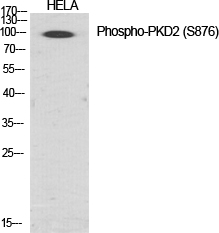Total PKD2 Cell-Based Colorimetric ELISA Kit
- Catalog No.:KA4244C
- Applications:ELISA
- Reactivity:Human;Mouse;Rat
- Gene Name:
- PRKD2
- Human Gene Id:
- 25865
- Human Swiss Prot No:
- Q9BZL6
- Mouse Swiss Prot No:
- Q8BZ03
- Rat Swiss Prot No:
- Q5XIS9
- Storage Stability:
- 2-8°C/6 months
- Other Name:
- Serine/threonine-protein kinase D2 (EC 2.7.11.13) (nPKC-D2)
- Detection Method:
- Colorimetric
- Background:
- catalytic activity:ATP + a protein = ADP + a phosphoprotein.,enzyme regulation:Activated by diacylglycerol and phorbol esters.,function:Calcium-independent, phospholipid-dependent, serine- and threonine-specific protein kinase.,PTM:Autophosphorylated. Phorbol esters stimulates autophosphorylation. Phosphorylation of Ser-876 correlates with the activation status of the kinase.,similarity:Belongs to the protein kinase superfamily.,similarity:Belongs to the protein kinase superfamily. CAMK Ser/Thr protein kinase family. PKD subfamily.,similarity:Contains 1 PH domain.,similarity:Contains 1 protein kinase domain.,similarity:Contains 2 phorbol-ester/DAG-type zinc fingers.,tissue specificity:Widely expressed.,
- Function:
- protein amino acid phosphorylation, phosphorus metabolic process, phosphate metabolic process, intracellular signaling cascade, phosphorylation,
- Subcellular Location:
- Cytoplasm . Cell membrane . Nucleus . Golgi apparatus, trans-Golgi network . Translocation to the cell membrane is required for kinase activation. Accumulates in the nucleus upon CK1-mediated phosphorylation after activation of G-protein-coupled receptors. Nuclear accumulation is regulated by blocking nuclear export of active PRKD2 rather than by increasing import. .
- Expression:
- Widely expressed.
- June 19-2018
- WESTERN IMMUNOBLOTTING PROTOCOL
- June 19-2018
- IMMUNOHISTOCHEMISTRY-PARAFFIN PROTOCOL
- June 19-2018
- IMMUNOFLUORESCENCE PROTOCOL
- September 08-2020
- FLOW-CYTOMEYRT-PROTOCOL
- May 20-2022
- Cell-Based ELISA│解您多样本WB检测之困扰
- July 13-2018
- CELL-BASED-ELISA-PROTOCOL-FOR-ACETYL-PROTEIN
- July 13-2018
- CELL-BASED-ELISA-PROTOCOL-FOR-PHOSPHO-PROTEIN
- July 13-2018
- Antibody-FAQs


